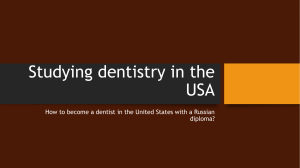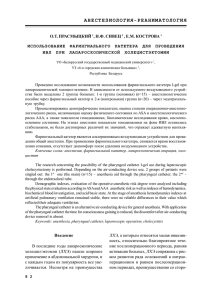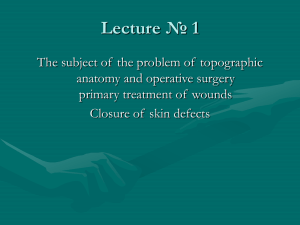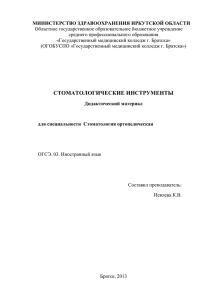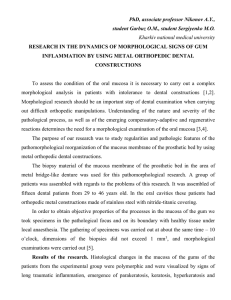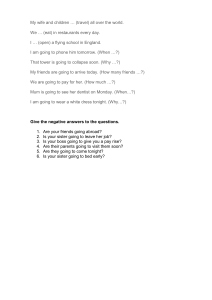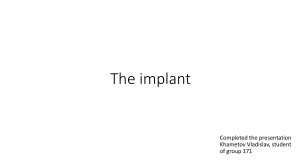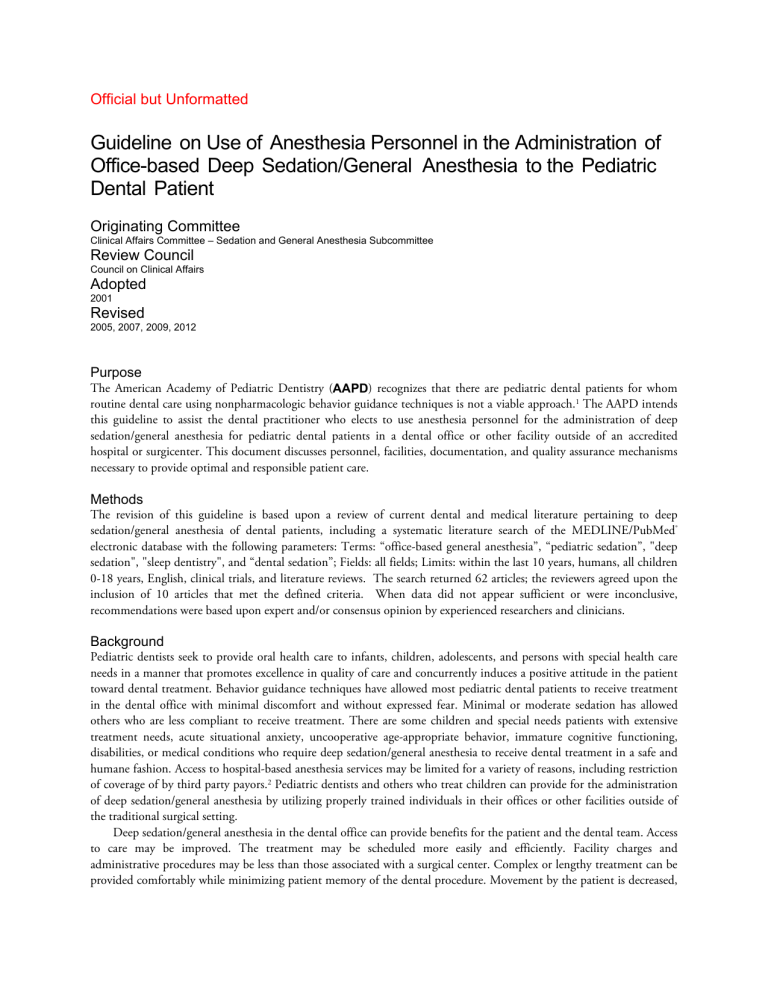
Official but Unformatted Guideline on Use of Anesthesia Personnel in the Administration of Office-based Deep Sedation/General Anesthesia to the Pediatric Dental Patient Originating Committee Clinical Affairs Committee – Sedation and General Anesthesia Subcommittee Review Council Council on Clinical Affairs Adopted 2001 Revised 2005, 2007, 2009, 2012 Purpose The American Academy of Pediatric Dentistry (AAPD) recognizes that there are pediatric dental patients for whom routine dental care using nonpharmacologic behavior guidance techniques is not a viable approach.1 The AAPD intends this guideline to assist the dental practitioner who elects to use anesthesia personnel for the administration of deep sedation/general anesthesia for pediatric dental patients in a dental office or other facility outside of an accredited hospital or surgicenter. This document discusses personnel, facilities, documentation, and quality assurance mechanisms necessary to provide optimal and responsible patient care. Methods The revision of this guideline is based upon a review of current dental and medical literature pertaining to deep sedation/general anesthesia of dental patients, including a systematic literature search of the MEDLINE/PubMed® electronic database with the following parameters: Terms: “office-based general anesthesia”, “pediatric sedation”, "deep sedation", "sleep dentistry", and “dental sedation”; Fields: all fields; Limits: within the last 10 years, humans, all children 0-18 years, English, clinical trials, and literature reviews. The search returned 62 articles; the reviewers agreed upon the inclusion of 10 articles that met the defined criteria. When data did not appear sufficient or were inconclusive, recommendations were based upon expert and/or consensus opinion by experienced researchers and clinicians. Background Pediatric dentists seek to provide oral health care to infants, children, adolescents, and persons with special health care needs in a manner that promotes excellence in quality of care and concurrently induces a positive attitude in the patient toward dental treatment. Behavior guidance techniques have allowed most pediatric dental patients to receive treatment in the dental office with minimal discomfort and without expressed fear. Minimal or moderate sedation has allowed others who are less compliant to receive treatment. There are some children and special needs patients with extensive treatment needs, acute situational anxiety, uncooperative age-appropriate behavior, immature cognitive functioning, disabilities, or medical conditions who require deep sedation/general anesthesia to receive dental treatment in a safe and humane fashion. Access to hospital-based anesthesia services may be limited for a variety of reasons, including restriction of coverage of by third party payors.2 Pediatric dentists and others who treat children can provide for the administration of deep sedation/general anesthesia by utilizing properly trained individuals in their offices or other facilities outside of the traditional surgical setting. Deep sedation/general anesthesia in the dental office can provide benefits for the patient and the dental team. Access to care may be improved. The treatment may be scheduled more easily and efficiently. Facility charges and administrative procedures may be less than those associated with a surgical center. Complex or lengthy treatment can be provided comfortably while minimizing patient memory of the dental procedure. Movement by the patient is decreased, and the quality of care may be improved. The dentist can use his/her customary in-office delivery system with access to trained auxiliary personnel, supplemental equipment, instrumentation, or supplies should the need arise. The use of anesthesia personnel to administer deep sedation/general anesthesia in the pediatric dental population is an accepted treatment modality.3-7 The AAPD supports the provision of deep sedation/general anesthesia when clinical indications have been met and additional properly-trained and credentialed personnel and appropriate facilities are used.1,3,7 In many cases, the patient may be treated in an appropriate out-patient facility (including the dental office) because the extensive medical resources of a hospital are not necessary. Recommendations Clinicians may consider using deep sedation or general anesthesia in the office to facilitate the provision of oral health care. Practitioners choosing to use these modalities must be familiar with their patient’s medical history and emergency procedures, as well as the regulatory and professional liability insurance requirements needed to provide this level of pharmacologic behavior management. This guideline does not supersede, nor is it to be used in deference to, federal, state, and local credentialing and licensure laws, regulations, and codes. Personnel Office-based deep sedation/general anesthesia techniques require at least 3 individuals. The anesthesia care provider’s responsibilities are to administer drugs or direct their administration and to observe constantly the patient’s vital signs, airway patency, cardiovascular and neurological status, and adequacy of ventilation.3 In addition to the anesthesia care provider, the operating dentist and other staff shall be trained in emergency procedures. It is the obligation of treating practitioners, when employing anesthesia personnel to administer deep sedation/general anesthesia, to verify their credentials and experience. 1. The anesthesia care provider must be a licensed dental and/or medical practitioner with appropriate and current state certification for deep sedation/general anesthesia. 2. The anesthesia care provider must have completed a 1- or 2-year dental anesthesia residency or its equivalent, as approved by the American Dental Association (ADA), and/or medical anesthesia residency, as approved by the American Medical Association (AMA). 3. The anesthesia care provider currently must be licensed by and in compliance with the laws of the state in which he/she practices. Laws vary from state to state and may supercede any portion of this document. 4. If state law permits a certified registered nurse anesthetist or anesthesia assistant to function under the supervision of a dentist, the dentist is required to have completed training in deep sedation/general anesthesia and be licensed or permitted, as appropriate to state law. The dentist and anesthesia care provider must be compliant with the American Academy of Pediatrics/AAPD’s Guideline on Monitoring and Management of Pediatric Patients During and After Sedation for Diagnostic and Therapeutic Procedures3 or other appropriate guideline(s) of the ADA, AMA, and their recognized specialties. The recommendations in this document may be exceeded at any time if the change involves improved safety and is supported by currently-accepted practice and/or is evidence-based. The dentist and anesthesia personnel must work together to enhance patient safety. Effective communication is essential. The dentist introduces the concept of deep sedation/general anesthesia to the parent and provides appropriate preoperative instructions and informational materials. The dentist or his/her designee coordinates medical consultations when necessary. The anesthesia care provider explains potential risks and obtains informed consent for sedation/anesthesia. Office staff should understand their additional responsibilities and special considerations (eg, loss of protective reflexes) associated with office-based deep sedation/general anesthesia. Advanced training in recognition and management of pediatric emergencies is critical in providing safe sedation and anesthetic care. There must be 1 person available whose only responsibilities are to constantly observe the patient's vital signs, airway patency, and adequacy of ventilation and to either administer drugs or direct their administration. At least 1 individual who is trained in and capable of providing advanced pediatric life support and who is skilled in airway management and cardiopulmonary resuscitation must be present; training in pediatric advanced life support is required.3 An individual experienced in recovery care must be in attendance in the recovery facility until the patient, through continual monitoring, exhibits respiratory and cardiovascular stability and appropriate discharge criteria3 have been met. In addition, the staff of the treating dentist must be well-versed in rescue and emergency protocols (including cardiopulmonary resuscitation) and have contact numbers for emergency medical services and ambulance services. Emergency preparedness must be updated and practiced on a regular basis. Facilities A continuum exists that extends from wakefulness across all levels of sedation. Often these levels are not easily differentiated, and patients may drift through them. When anesthesia care providers are utilized for office-based administration of deep sedation or general anesthesia, the facilities in which the dentist practices must meet the guidelines and appropriate local, state, and federal codes for administration of the deepest possible level of sedation/anesthesia. Facilities also should comply with applicable laws, codes, and regulations pertaining to controlled drug storage, fire prevention, building construction and occupancy, accommodations for the disabled, occupational safety and health, and disposal of medical waste and hazardous waste.4 The treatment room must accommodate the dentist and auxiliaries, the patient, the anesthesia care provider, the dental equipment, and all necessary anesthesia delivery equipment along with appropriate monitors and emergency equipment. Expeditious access to the patient, anesthesia machine (if present), and monitoring equipment should be available at all times. It is beyond the scope of this document to dictate equipment necessary for the provision of deep sedation/general anesthesia, but equipment must be appropriate for the technique used and consistent with the guidelines for anesthesia providers, in accordance with governmental rules and regulations. Because laws and codes vary from state to state, the Guideline on Monitoring and Management of Pediatric Patients During and After Sedation for Diagnostic and Therapeutic Procedures3 should be followed as the minimum requirements. For deep sedation, there shall be continuous monitoring of oxygen saturation and heart rate and intermittent time-based recording of respiratory rate and blood pressure. When adequacy of ventilation is difficult to observe, use of a precordial stethoscope or capnograph is encouraged.3 An electrocardiographic monitor should be readily available for patients undergoing deep sedation. In addition to the monitors previously mentioned, a temperature monitor and pediatric defibrillator are required for general anesthesia.3 Emergency equipment must be readily accessible and should include suction, drugs necessary for rescue and resuscitation (including 100% oxygen capable of being delivered by positive pressure at appropriate flow rates for up to 1 hour), and age-/size-appropriate equipment to resuscitate and rescue a non-breathing and/or unconscious pediatric dental patient and provide continuous support while the patient is being transported to a medical facility.3,8 The treatment facility should have medications, equipment, and protocols available to treat malignant hyperthermia when triggering agents are used.4 Recovery facilities must be available and suitably equipped. Back up power sufficient to ensure patient safety should be available in case of an emergency.4 Documentation Prior to delivery of deep sedation/general anesthesia, patient safety requires that appropriate documentation shall address rationale for sedation/general anesthesia, informed consent, instructions to parent, dietary precautions, preoperative health evaluation, and any prescriptions along with the instructions given for their use.3 Because laws and codes vary from state to state, the Guideline on Monitoring and Management of Pediatric Patients During and After Sedation for Diagnostic and Therapeutic Procedures3 should be followed as minimum requirements for a time-based anesthesia record. 1. Vital signs: Pulse and respiratory rates, blood pressure, and oxygen saturation must be monitored and recorded at least every 5 minutes3 throughout the procedure and at specific intervals until the patient has met documented discharge criteria. 2. Drugs: Name, dose, route, site, time of administration, and patient effect of all drugs, including local anesthesia, must be documented. When anesthetic gases are administered, inspired concentration and duration of inhalation agents and oxygen shall be documented. 3. Recovery: The condition of the patient, that discharge criteria have been met, time of discharge, and into whose care the discharge occurred must be documented. Requiring the signature of the responsible adult to whom the child has been discharged, verifying that he/she has received and understands the post-operative instructions, is encouraged. Various business/legal arrangements may exist between the treating dentist and the anesthesia provider. Regardless, because services were provided in the dental facility, the dental staff must maintain all patient records, including timebased anesthesia records, so that they may be readily available for emergency or other needs. The dentist must assure that the anesthesia provider also maintains patient records and that they are readily available. Risk management and quality assurance Dentists who utilize in-office anesthesia care providers must take all necessary measures to minimize risk to patients. The dentist must be familiar with the American Society of Anesthesiologists (ASA) physical status classification. Knowledge, preparation, and communication between professionals are essential.9 Prior to subjecting a patient to deep sedation/general anesthesia, the patient must undergo a preoperative health evaluation.3,10 High-risk patients should be treated in a facility properly equipped to provide for their care.3,10 The dentist and anesthesia care provider must communicate during treatment to share concerns about the airway or other details of patient safety. Furthermore, they must work together to develop and document mechanisms of quality assurance. Untoward and unexpected outcomes must be reviewed to monitor the quality of services provided. This will decrease risk, allow for open and frank discussions, document risk analysis and intervention, and improve the quality of care for the pediatric dental patient. References 1. American Academy of Pediatric Dentistry. Guideline on behavior guidance for the pediatric dental patient. Pediatr Dent 2011;33(special issue):161-73. 2. Glassman P, Caputo A, Dougherty N, et al. Special Care Dentistry Association consensus statement on sedation, anesthesia, and alternative techniques for people with special needs. Spec Care Dentist 2009;29(1):2-8; quiz 67-8. 3. American Academy of Pediatrics, American Academy of Pediatric Dentistry. Guideline for monitoring and management of pediatric patients during and after sedation for diagnostic and therapeutic procedures. Pediatr Dent 2010;32(special issue):167-83. 4. American Society of Anesthesiologists. Guidelines for office-based anesthesia. 2009. Available at: “http://asahq.org/For-Healthcare-Professionals/Standards-Guidelines-and-Statements.aspx". Accessed June 24, 2012. 5. American Dental Association. Policy statement 384: The use of sedation and general anesthesia by dentists. 2007:65-6. Available at: "http://www.ada.org/sections/about/pdfs/doc_policies.pdf". Accessed June 24, 2012. 6. Nick D, Thompson L, Anderson D, Trapp L. The use of general anesthesia to facilitate dental treatment. Gen Dent 2003;51:464-8. 7. Wilson S. Pharmacologic behavior management for pediatric dental treatment. Pediatr Clinic North Am 2000;47(5):1159-73. 8. American Society of Anesthesiologists. Guidelines for ambulatory anesthesia and surgery. 2008. Available at: “http://asahq.org/For-Healthcare-Professionals/Standards-Guidelines-and-Statements.aspx”. Accessed June 24, 2012. 9. American Society of Anesthesiologists. ASA physical status classification system. Available at: “http://www.asahq.org/For-Members/Clinical-Information/ASA-Physical-Status-ClassificationSystem.aspx”. Accessed June 24, 2012. 10. American Dental Association. Guidelines for the use of sedation and general anesthesia by dentists. 2007. Available at: “http://www.ada.org/sections/about/pdfs/anesthesia_guidelines.pdf”. Accessed June 24, 2012.
